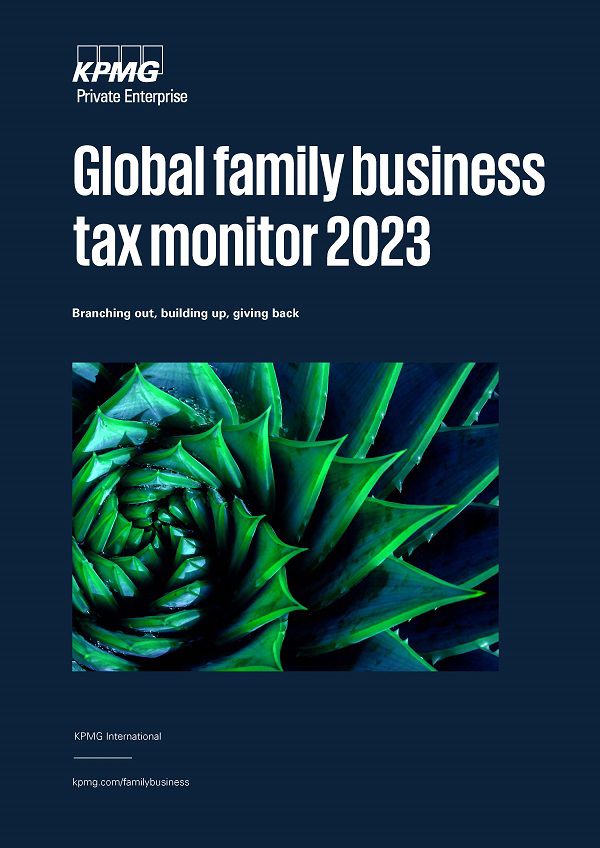For many family businesses, sustaining prosperity for the long run depends on how well they plan transfers of business assets and family wealth from one generation to the next.
Beyond the emotional concerns these transfers entail, tax, legal and a host of other issues come into play. Today these issues are multiplying as the pandemic lingers, geopolitical tensions run high, recession looms, and technology opens opportunities for new business models and ways of doing business.
Taxing family business transfers — a world of differences
In this report, KPMG Private Enterprise advisers offer a snapshot of the domestic tax rules governing family business transfers and provide a detailed analysis of the outcomes of two case studies in which the shares in a family business are transferred on the owner’s death (inheritance) and in which the transfer happens during the owner’s lifetime (gifting).
The case studies in our report show there are significant disparities between tax regimes on whether :
- a specific tax relief is available and what conditions must be met to gain that tax relief
- taxes are applied on inheritances and family gifts directly or through other taxes and charges, such as capital gains taxes and stamp duties.
With more business families globalizing, family members more globally mobile and assets being diversified geographically, it’s imperative that family businesses consider the tax implications as well as the business and personal factors when planning a family business transfer.
KPMG Private Enterprise’s Global family business tax monitor 2023 compares the vastly different tax implications of transferring the family business through gifting during the owners’ lifetime (including on retirement) and through inheritance across 57 countries, territories and jurisdictions worldwide.
Click on the map to view our interactive analysis and compare tax implications across 57 jurisdictions worldwide.
Domestic tax rules are only one factor helping to drive succession, investment and business planning. For broader context, this year’s report surveys the lay of the land for today’s business families, with insights on some of their biggest risks and priorities distilled from interviews with KPMG Private Enterprise leaders and advisers in selected countries, territories and jurisdictions.
Key highlights

Top global trends influencing business family planning
The Global family business tax monitor 2023 gathers insights from KPMG Private Enterprise advisers in KPMG firms worldwide, highlighting three emerging trends that business families should consider as they develop their long-term plans for their businesses and their wealth.
Branching out
More business families and their assets are going global
KPMG Private Enterprise advisers say more of their business family clients are globalizing, with members more globally mobile, assets being diversified geographically, and businesses transitioning to greener models.
But as long-established global business families know, when people, activities and interests spread to ever more jurisdictions, the tax, legal and other risks can multiply.
As the pandemic lingers in some jurisdictions, these risks are especially heightened for wealthy families. Governments are now looking to them as a potential source of much-needed revenue to restore finances depleted by emergency relief delivered during the pandemic.
The tax landscape is always changing — creating both opportunity and risk — so business families with footprints in multiple jurisdictions are advised to monitor potential new or increased taxes and consider taking action in advance.
Building up
Governance and managing family wealth are gaining priority
KPMG Private Enterprise advisers are seeing increased rigor in the management of family wealth in many jurisdictions, with more reliance on family offices and more focus on governance.
The transition often occurs as new generations are brought in to take part in the family’s business and wealth affairs. At this point, the family’s focus often turns from running the founding generation’s business to managing the family’s investments and capital for the long term.
Using a family office to manage the complexity of the family’s wealth is especially valuable for globalizing families as their members and assets spread across multiple jurisdictions, creating more cross-border risks from tax, legal and asset protection being the forefront risks.
The family office structure is crucial for supporting objectives, providing specialized advice for all family members and viewing their wealth management holistically to avoid blind spots in identifying opportunity and risk.
This gets even more important from one generation to the next as the family’s holdings get larger and more diverse, and the base of family shareholders multiplies.
Giving Back
Philanthropic activities are drawing more attention
Business families have always played a philanthropic role, but the sharpening focus on transparency and environmental, social and governance (ESG) reporting (for the family business) is compelling many of them to be more public about their contributions.
Part of this entails a change in how families are defining the purpose of wealth beyond capital. Just as attitudes in the corporate world have come to accept the company’s broader social obligations beyond its shareholders, definitions of family wealth are evolving beyond purely financial wealth to encompass other contributions that benefit the community.
In addition to traditional benevolent activities, many business families are seeking business models that earn financial profits while helping their communities prosper more broadly.
Business families often coordinate their philanthropic work through a form of family foundation, with operations dedicated to evaluating investment opportunities and determining how to deploy capital for various philanthropic endeavors.
Depending on the jurisdiction, however, other structures, such as donor-advised funds, could be used to achieve the family’s objectives more cost-effectively.
With all of these forces at work, where should business families focus their attention when planning for succession?
The report highlights many of the biggest risks and priorities driving succession, investment and business planning for business families in 2023 and the years to come.






